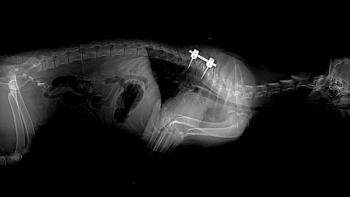
Anesthesia for patients with neurologic disease (Proceedings)
Veterinary patients can present for a variety of diseases that impact the neurological system. These patients can require anesthesia for stabilization, diagnostic procedures, or surgical correction of these diseases.
Veterinary patients can present for a variety of diseases that impact the neurological system. These patients can require anesthesia for stabilization, diagnostic procedures, or surgical correction of these diseases. Most commonly, the spinal cord is the primary area of the central nervous system that is affected by disease with intervertabral disk disease presenting most frequently. However, with advances in diagnostic imaging capabilities (computed tomography and magnetic resonance imaging) and increasing availability, more and more patients with intracranial disease need to be anesthetized.
Anesthesia for patients with spinal cord disease
The most common causes of spinal cord disease in dogs requiring anesthesia include intervertabral disk disease (IVDD), traumatic injury, and fibrocartilaginous embolism (FCE). Other conditions of the spinal cord that may require anesthesia include neoplasia and congenital instability (wobblers and atlanto-axial malformation/luxation). For IVDD, dachshunds and beagles are the breeds most commonly affected. Dachshunds can propose a significant challenge for anesthesia due to difficult venous access and non-invasive blood pressure cuff placement due to short legs. Traumatic injury to the spinal column most often occurs secondary to motor vehicle involvement and can include spinal fracture as well as cord damage. Patients with FCE can be large breed dogs presenting down in the hind limbs and can be problematic for diagnosis as it is a diagnosis of exclusion and can require significant manpower.
Compression or damage to the spinal cord can result in high levels of pain to patients and can set the stage for chronic neuropathic pain. Analgesic therapy should be aggressive from the start and continue well through the post-anesthetic period.
Dogs with IVDD can be managed anesthetically taking into account the diagnostic imaging required and any preanesthetic treatments administered. Protocols based around a benzodiazepine and opioids with propofol as an induction agent are used to provide sedation and analgesia while limiting the possibility of imaging contrast induced seizure. Similar protocols can be used for other diagnostic procedure such as cerebral spinal fluid collection. After performing surgical decompression of the spinal cord in dogs with IVDD, post operative pain management is important and can be provided with options such as a "topical epidural", and constant rate infusions.
Anesthesia for patient with intracranial disease
When performing anesthesia for patient with intracranial disease, anesthetists must take into consideration the dynamics of intracranial pressure, cerebral blood flow, and cerebrospinal fluid production and flow. The blood supply of the central nervous system is controlled by a unique and delicate autoregulation system. Changes in blood flow can result from changes in oxygen tension, carbon dioxide tension, arterial blood pressure and venous outflow. Of these, carbon dioxide is one of the most sensitive. All of these factors can be manipulated to some degree by the anesthetist to achieve the best possible outcomes. The autoregulatory system of the central nervous system is greatly impacted by pharmacologic agents used during anesthesia and surgery and having an understanding of these changes by each class of drug is paramount. Inhalant anesthetics in particular can interfere and completely abolish the physiologic systems maintaining proper blood flow to the central nervous system and excessive amounts can result in catastrophic elevations in intracranial pressure. Inhalant sparing techniques are recommended to allow for better control of the central nervous system blood flow.
Within the cranial vault, there are three main tissue that interplay to form a pressure-volume relationship with intracranial pressure. The tissues within the vault can be categorized into three areas, the brain, blood, and CSF. The Monro-Kellie doctrine states that intracranial pressure is a result of the additive effect of these three tissues and an increase in one tissue must have a corresponding decrease in one or both of the other tissues to result in no change in intracranial pressure
Intracranial Pressure = Brain + Blood + CSF
Normal intracranial pressure ranges from 0 to 10 mm Hg and excessive elevations can lead to brain herniation and death. In patients where an increase in intracranial pressure is suspected, manipulations of the three tissues within the skull can be manipulated to try to maintain normality. For the anesthetist, recognition of signs related to increasing intracranial pressure in anesthetized patients is imperative. The Cushings's reflex is a decrease in heart rate as a response to increases in systemic vascular resistance or blood pressure. In patients with intracranial disease, the Cushing's reflex can be a sign on increasing intracranial pressue. Cerebral perfusion pressure is the pressure gradient necessary for blood to flow toward the brain from the body to ensure perfusion of the brain. This can be described with the following formula: Cerebral Perfusion Pressure = Mean Arterial Pressure – Intracranial Pressure
Based on this formula, if intracranial pressure increases, mean arterial pressure must have a corresponding increase to maintain cerebral perfusion pressure. When mean arterial pressure increases, the Cushing's reflex occur and heart rate decreases. Therefore, if the mean arterial pressure suddenly increases and heart rate decreases in a patient with suspected intracranial disease, increased intracranial pressure should be suspected and treatment initiated.
Treatment for the anesthetized patient with increased intracranial pressure is aimed at reducing the volume of the three previously mentioned tissues. Mannitol can be administered to reduce neuronal cell water content and promote diuresis. The patient can be hyperventilated to an end tidal carbon dioxide level between 28 and 32 mm Hg to constrict cerebral vasculature and reduce blood volume. Corticosteroids are administered to reduce inflammation and stabilize cellular membranes.
Anesthetic protocols for patients with suspected intracranial disease are based on opioids for sedation and analgesia and use of techniques that minimize or eliminate inhalants. A propofol bolus for induction and a constant rate of infusion of propofol for maintenance is recommended. Inhalant anesthetics minimize the body's ability to autoregulate blood flow within and to the brain. Opioid infusions can be used with the propofol to provide analgesia and reduce the amount of propofol needed. Fentanyl is commonly used as an infusion during anesthesia and can be used in these cases. Remifentanil is a newer opioid that has a unique use with neurologic patients. It has an extremely short half-life of less than 10 minutes. Therefore, for patients undergoing neurologic surgical procedures, at recovery, remifentanil can be discontinued and patients can then be quickly assessed for neurologic function without residual opioid effects interfering.
Anesthesia for patients with seizure disorders
Patients with chronic seizure disorders can present to veterinarians for anesthesia for unrelated conditions such as dental prophylaxis in day to day practice. These patients can be anesthetized safely provided the anesthetist has an understanding of the properties of individual anesthetic and analgesic drugs on seizure threshold to formulate appropriate protocols. Protocols built around opioids and propofol in most cases will limit seizure potential whereas drugs such as ketamine should be avoided. Additionally, if the patient is currently being administered chronic anti-seizure medications, anesthetic drug requirements may be decreased and recovery can be prolonged.
Newsletter
From exam room tips to practice management insights, get trusted veterinary news delivered straight to your inbox—subscribe to dvm360.




